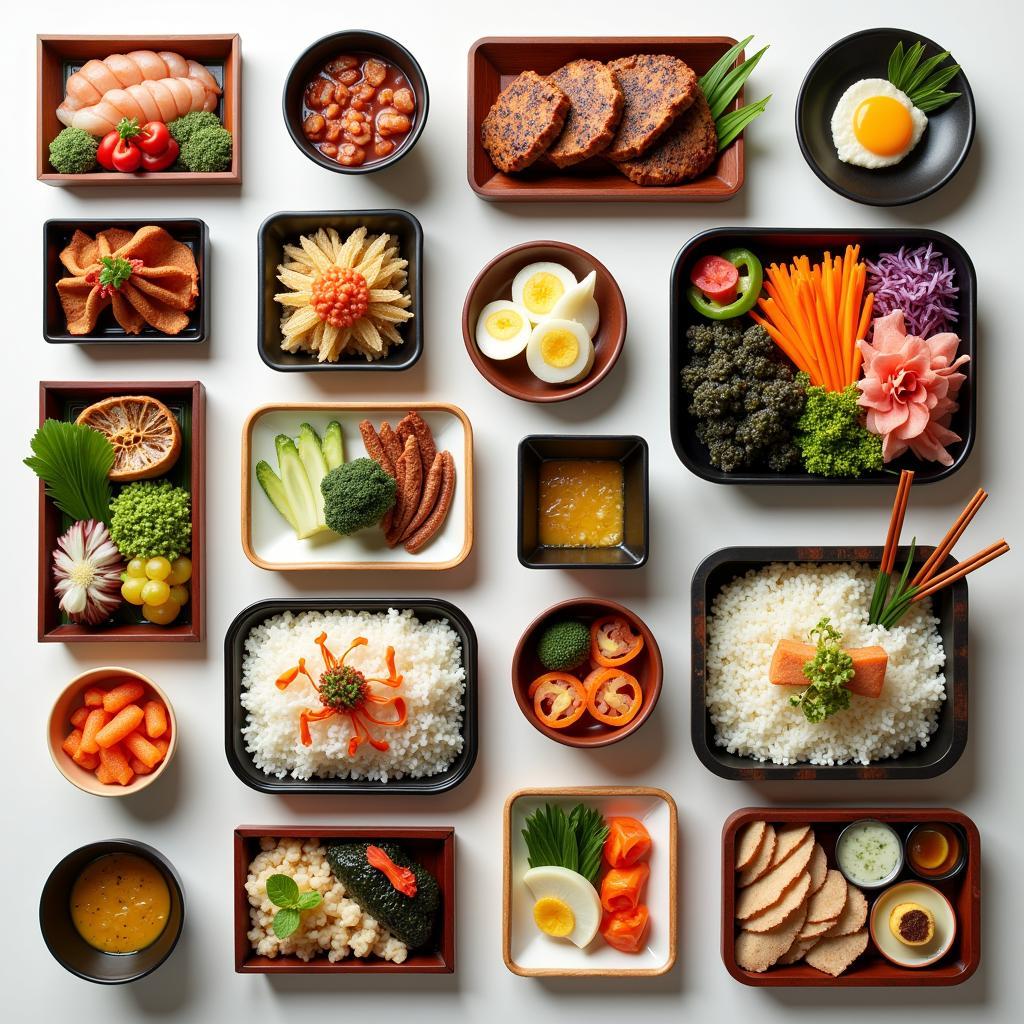Japan is renowned for its exquisite cuisine, but the beauty of Japanese food extends far beyond the taste. Presentation is paramount, and the vessels used to serve Japanese dishes are just as important as the ingredients themselves. Japanese Food Containers, from delicate lacquerware to minimalist ceramic bowls, elevate dining into an art form.
This guide delves into the world of Japanese food containers, exploring their history, variety, and the cultural significance they hold. Whether you’re a seasoned enthusiast of Japanese cuisine or a curious newcomer, this exploration will equip you to choose the perfect vessels to enhance your dining experience.
The Art of Japanese Food Presentation: More Than Just Containers
In Japan, food presentation is an integral part of the culinary experience. It’s about showcasing the natural beauty of the ingredients and creating a harmonious balance of colors, textures, and shapes. Japanese food containers are not mere vessels but carefully chosen pieces that complement and enhance the food they hold.
 Variety of Japanese Food Containers
Variety of Japanese Food Containers
A Journey Through Time: History of Japanese Food Containers
The evolution of Japanese food containers reflects the country’s rich history and evolving culinary traditions. From simple earthenware in ancient times to the refined lacquerware of the Edo period, each era has left its mark on these essential dining elements.
Ancient Origins: Earthenware and Simplicity
In ancient Japan, practicality dictated the choice of food containers. Earthenware, readily available and durable, was the primary material. Simple bowls and plates, often unglazed, were used for serving daily meals.
The Rise of Lacquerware: Elegance and Artistry
The introduction of lacquerware during the Heian period (794-1185) marked a turning point in Japanese tableware. Lacquer, a natural resin, was meticulously applied in multiple layers to create durable and beautiful finishes. Lacquerware became a symbol of status and refinement, often adorned with intricate designs and gold leaf.
Modern Influences: Functionality and Diversity
Today, Japanese food containers encompass a wide range of materials and styles, reflecting modern lifestyles and global influences. While traditional materials like lacquerware and ceramic remain popular, contemporary designs incorporate glass, plastic, and even wood, prioritizing both aesthetics and practicality.
Navigating the Variety: Types of Japanese Food Containers
Understanding the different types of Japanese food containers is key to selecting the right one for each dish and occasion. Here’s a closer look at some common varieties:
-
Donburi: Deep bowls used for serving donburi, rice bowls topped with meat, vegetables, and sauce.
-
Chawan: Small bowls ideal for serving rice, soup, and desserts.
-
Owan: Larger bowls often used for soups, noodles, and nimono (simmered dishes).
-
Kobachi: Tiny bowls perfect for serving side dishes, pickles, and condiments.
-
Jushibako: Tiered japanese food box commonly used for bento lunches.
-
Hangiri: Large, shallow wooden tubs used for preparing and serving sushi rice.
Choosing the Right Container: Factors to Consider
-
Type of food: The shape and size of the container should complement the dish being served.
-
Occasion: Formal occasions call for elegant lacquerware, while casual meals allow for more rustic or modern options.
-
Material: Each material has its own aesthetic and practical benefits, from the heat retention of ceramic to the lightweight nature of plastic food boxes.
-
Aesthetics: Consider the colors, patterns, and overall design of the container and how they harmonize with the food and table setting.
Beyond Functionality: The Cultural Significance
Japanese food containers are more than just practical items; they are deeply intertwined with the country’s cultural values.
-
Wabi-sabi: The appreciation for imperfection and natural beauty is reflected in the use of rustic and hand-crafted containers.
-
Seasonal Sensitivity: Containers often feature motifs inspired by the changing seasons, connecting the dining experience to nature’s rhythm.
-
Respect for Ingredients: The careful selection of containers demonstrates respect for the ingredients and the effort put into preparing the meal.
Japanese Food Containers: An Extension of Culinary Art
Japanese food containers are an essential element of Japanese cuisine, elevating dining into an art form. By understanding their history, variety, and cultural significance, you can choose the perfect vessels to enhance your enjoyment of Japanese food and appreciate the beauty and tradition they represent.
FAQs about Japanese Food Containers
-
What is the most common material for Japanese food containers?
Ceramic is the most prevalent material, known for its durability, heat retention, and versatility.
-
Are Japanese food containers dishwasher and microwave safe?
While many modern containers are dishwasher and microwave safe, it’s essential to check the manufacturer’s instructions, especially for delicate lacquerware.
-
Where can I buy authentic Japanese food containers?
You can find them in Japanese supermarkets, specialty kitchenware stores, and online retailers.
-
How do I care for my Japanese food containers?
Handwashing is generally recommended for delicate materials. Avoid abrasive cleaners and allow containers to dry completely before storing.
-
Can I use Japanese food containers for other cuisines?
Absolutely! Their versatility makes them suitable for various cuisines, adding a touch of elegance to any meal.
Need More Information?
For a deeper dive into specific types of Japanese food containers, explore these articles:
-
Wooden food container: Discover the beauty and functionality of these natural containers.
-
3 compartment food container: Learn about the practicality and convenience of these containers for packed lunches.
-
box for japanese food: Explore the world of bento boxes and their role in Japanese culinary culture.
For any inquiries or assistance in finding the perfect Japanese food containers, don’t hesitate to contact us.
Contact Us:
Phone: 02437655121
Email: [email protected]
Address: 3PGH+8R9, ĐT70A, thôn Trung, Bắc Từ Liêm, Hà Nội, Việt Nam.
Our dedicated customer service team is available 24/7 to assist you.